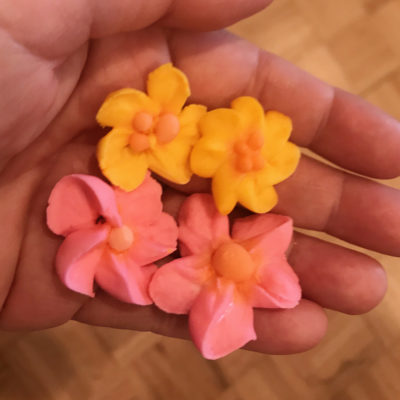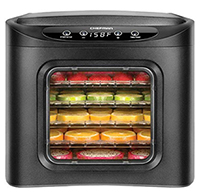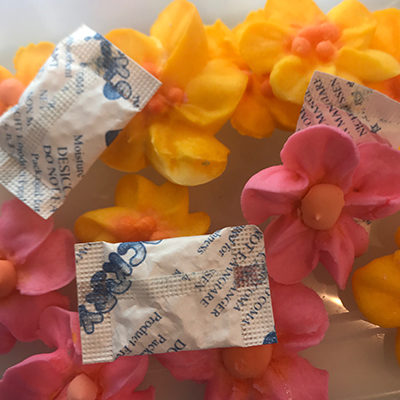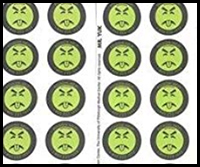Royal Icing: Humidity and Royal Icing Storage (Updated 6/5/19)
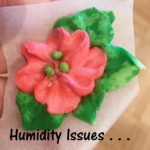
Humidity, whether present when you decorate with Royal Icing, when you serve your decorated cookies, or when you store your icing transfers or cookies themselves, will ruin your work.
This article is about how to prevent problems related to humidity, and possibly how to fix damaged icing or cookies due to humidity and condensation. The good thing about decorating with Royal Icing, however, if all goes wrong, you can always eat your work.
Why Condensation Forms
Air contains water, which we know of as “water vapor.” Condensation transforms the vapor (or gas) in the air into physical water.
In a high humidity environment, water vapor gets absorbed into porous surfaces such as cloth, wood, and yes, baked goods like cookies. This makes these objects damp. On non-porous surfaces, you’ll see thin traces of puddled water.
Sugar cookies as well as Royal Icing soak up the results of condensation. Unfortunately, the best sugar cookies are crisp, a condition that can only be achieved in low humidity. Even if you bake and ice your cookies in an environment with an ideal humidity, shipping and serving environments whose humidity and/or heat is high can ultimately change cookie and icing textures.
Example: Baked products (bread, cookies, pastry) sold outside at many farmer’s markets tend to be moister than when sold in a climate-controlled bakery.
Condensation on Frozen and Refrigerated Cookies
If you froze your cookies and find that they become moist or wet when defrosting at room temperature, it is because condensation (water) forms when humid (wet), atmospheric air contacts a cold surface. As air cools against your frozen package, it releases its moisture which appears on and in your package as water drops or puddles.
Always defrost frozen cookies with lids off in your refrigerator (which, if working correctly, has low humidity inside). Check periodically to make sure that moisture isn’t forming on or in your package as it defrosts. If it is, wipe it off!
Hopefully, your kitchen’s atmospheric air is not humid when you remove your cookies from refrigeration. If it is, a similar problem occurs, with your cookies quickly soaking up the newly released moisture. (See more information in the “Solutions” sections at the end of this article.)
Other Problems
- If your environment is not air conditioned, avoid decorating cookies when the humidity is over 70%: High humidity softens sugar cookies and prohibits icing from quickly drying, leading to damp icing that causes colors to bleed into each other.
- Even if it is cool out, but the humidity is high, consider running your air conditioner to lower your household humidity. Wear a sweater if needed.
- If possible, use a dehumidifier in your work area if moisture is an ongoing problem.
- Never put a plate of beautifully decorated cookies out in a hot, high-humidity atmosphere (like at a lake-side picnic) as they will turn soft.
- If you transport cookies, do not do it in a hot environment, even if your cookies are tightly packaged, as butter melts, causing the sugar cookies to soften.
- If you transport cookies by mail, make sure every cookie is completely dry and packaged in some type of air-tight container. Consider placing a silicon “anti-humidity” packets in the container, too.
- Do not refrigerate or freeze Royal Icing or cookies without proper preparations, as discussed below.
- Do not store Royal Icing or cookies if they have already started to soften, a condition that indicates that they are too moist.
The photo below shows what high humidity can do to Royal Icing:
The darker the colors, the more evidence of how moisture condensation from high humidity can be seen. In the above photo, notice the areas where the dark green bled into the pink. The bleeding does not appear as much between compatible pastel colors, but it still exists, as seen below:
Solutions
Under all circumstances, invest in an inexpensive humidity gauge and consult it before you start baking, decorating, storing, or defrosting cookies.
Ideally, you’ll protect your iced cookies and serve fresh products within a day or so of completion. If, however, you must store your cookies for days or weeks, but your atmosphere is not perfect, try these solutions:
- If your non-iced cookies start to soften, lightly re-bake them at a very low (100 degree or under) temperature. Perhaps heat your oven to 200, turn it off, then insert your cookies and let them sit for a few minutes. You’ll need to test the procedure that works best for you. If your cookies are still soft, boost the temperature.
- I do not own a food dehumidifier, but I suspect if you have one, it would work well. Most home food dehumidifiers are small, so if space matters, experiment between it and the oven method. A recent comment exchange on Julia Usher’s Facebook Group discussed the Chefman Food Dehydrator Machine. The woman who highly recommended this machine lives in New Jersey where the wetlands and coastal areas influence the atmosphere, so I’m inclined to believe her.
- For a few days, you can store your cookies in an air-tight container placed in a dry, cool area.
- If you must refrigerate or freeze your iced cookies:
- Cool your cookies and its containers to the temperature of the refrigerator or freezer.
- Quickly package your cookies. Your objective is to have the least amount of open area in your packaging.
- If possible, use vacuum packaging to remove the extra air (which contains water vapor) from your package.
- Before closing your package, once again cool it to a refrigerator or freezer temperature, then close it tightly or vacuum seal it.
- When ready to use, bring it to room temperature slowly. If you froze your package, open it and let it defrost in the refrigerator. If you refrigerated it, open and let your package sit in the refrigerator for an hour or so before introducing it to kitchen’s environment.
Note: Make sure your refrigerator and freezer work properly as equipment with poor sealing or clogged draining can have interior high humidity which causes the condition known as “sweating.”
For further protection, include food-safe silicon packets, such as available in this assortment sold on Amazon and other online retailers, which absorb moisture. Do not, however, put these directly against the cookies.
Silicon must not be eaten or mistaken for food, so obviously take care when storing treats if children are around. “Food Safe” silicon packages might answer your need, but still keep all packets out of the hands of kids. If, however, you have taken precautions, but are still concerned, paste a Mr. Yuck or other poison-alert sticker on each one, like seen below:
Shipping
It is easier to ship chewy cookies, than crispy. For general advice about shipping, read “5 Mistakes to Avoid When Packing & Shipping Cookies by Maggie Battista,” first published on TheKitchen.com, December 2016.
If your package is very delicate and important, consult online information on “packaging food for mailing.”
Links
- “Food Safe” silicon packets, among many brands, are sold on Amazon and other online shops.
- Mr. Yuck or other poison stickers.
- A general Internet search for “food dehumidifiers” turns up many potential solutions.
- 5 Mistakes to Avoid When Packing & Shipping Cookies by Maggie Battista,” first published on TheKitchen.com, December 2016.
- The Chefman Food Dehydrator Machine, as recommended by a participant on Julia Usher’s Facebook Group.
- Google searches:
- How Do Bakeries Handle Humidity – general search
- The Importance of Humidity Control in Bakeries – PolygonGroup.com
- 5 Tips For Successful Baking in High Humidity – FarmersAlmanac.com
- Relative Humidity – BakerPedia.com
Questions? Comments? Additions? Corrections? Write to Karen Little at Karen@Littleviews.com
Written for Littleviews-Crafts.com by Karen Little, publisher, on May 12, 2019. All rights reserved, but feel free to re-publish this article after contacting Karen so she knows where to find it.

